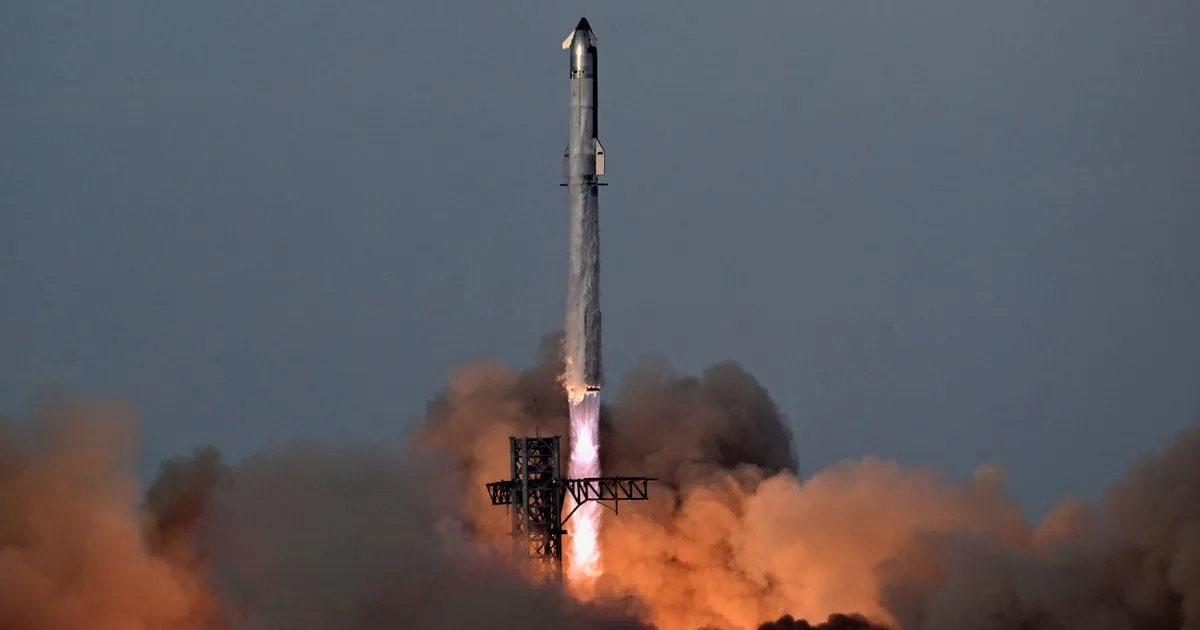
After a delay of two days, SpaceX successfully launched its massive Super Heavy-Starship on Tuesday, marking a significant moment in the ongoing journey of space exploration. This launch comes after three previous catastrophic failures earlier in the year, creating heightened anticipation for this high-stakes return-to-flight. At exactly 7:30 p.m. ET, the Super Heavy booster's 33 methane-fueled Raptor engines ignited with a thunderous roar, propelling the 40-story-tall rocket from SpaceX's Starbase facility located on the Texas Gulf Coast.
The initial launch attempt on Sunday had to be canceled due to issues with ground equipment, and a second attempt on Monday was thwarted by overcast weather conditions. However, the skies cleared for Tuesday's launch, allowing the rocket—recognized as the most powerful ever constructed—to soar into the atmosphere with an astonishing thrust of approximately 16 million pounds. This power is more than double that of NASA's Space Launch System moon rocket and the iconic Saturn V.
Despite the success of this launch, concerns linger regarding the development of a moon lander variant of the Starship, which is being built for NASA's upcoming missions. There are apprehensions that it may not reach perfection in time for a planned moon landing in 2027, especially with the possibility of China planting its flag on the lunar surface by the end of the decade. Nevertheless, the initial stages of this 10th Super Heavy-Starship test flight appeared to unfold without issues.
The 230-foot-tall Super Heavy booster effectively propelled the Starship upper stage beyond the dense lower atmosphere. Following separation, the booster performed a successful flip and utilized its engines to guide itself back to a planned splashdown off the Texas Gulf Coast. During this mission, flight controllers monitored the booster’s performance, deliberately shutting down landing engines to simulate potential failures.
The Starship upper stage successfully entered a suborbital trajectory as intended, targeting a splashdown in the Indian Ocean 1 hour and 6 minutes post-launch. This was a notable improvement compared to earlier flights, where the Starship stage was lost due to propellant leaks and engine issues. On this occasion, the stage reached engine cutoff as scheduled nine minutes after liftoff, demonstrating improved reliability.
Following the launch, the flight plan included deploying eight Starlink satellite simulators to test the innovative deployment mechanism. Additionally, one of the six Raptor engines was reignited to verify its restart capabilities in space. During reentry, SpaceX planned to assess new heat shield tiles and determine the heat tolerance of the rocket's skin without tile protection.
Both the Super Heavy booster and the Starship are designed for autonomous return to the launch gantry, yet SpaceX has yet to attempt a return-to-launch-site maneuver with a Starship. Instead, the rocket splashed down tail-first in the Indian Ocean. This successful test flight is crucial for SpaceX, which aims to resolve any issues swiftly to commence operational missions involving numerous Starlink launches and, ultimately, transporting settlers and equipment to Mars.
NASA is equally reliant on SpaceX's advancements, as they are counting on a modified version of the Starship to facilitate two astronauts' journey to the moon's surface as early as 2027. Given that the rocket is fully reusable, the moon lander will consume all its propellant merely reaching low-Earth orbit. Consequently, SpaceX must execute 10 to 20 Super Heavy tanker flights to refuel the lander before its lunar mission.
The challenge of counteracting the natural warming of the liquid oxygen and methane fuel, which can lead to gas venting, adds complexity to the mission. Furthermore, no orbit-class rockets have successfully demonstrated the rapid-launch cadence required for such operations, nor have they autonomously transferred massive amounts of cryogenic propellants in the challenging environment of space.
Any launch failure could jeopardize a moon mission, resulting in thorough investigations. Moreover, an explosive failure in low-Earth orbit could create hazardous debris. Safely landing on the moon with a 16-story-tall rocket also presents unique challenges, including navigating uneven terrain or loosely packed soil that could lead to tipping.
As experts weigh in on the feasibility of a 2027 moon landing, many believe that SpaceX faces significant hurdles. Interviews with current and former NASA managers and engineers indicate a consensus that the current Human Landing System (HLS) architecture may not support a safe mission by 2027, with doubts about the timeline to outpace China’s lunar ambitions.
A senior engineer involved with the Artemis program expressed skepticism about the viability of a crewed Starship reaching the moon by 2030, stating, “We are not going to go ahead and get a crewed Starship to the moon by 2030, under any circumstances.” While acknowledging the potential for success in the future, they emphasized the substantial technical challenges that must be overcome in a limited timeframe.